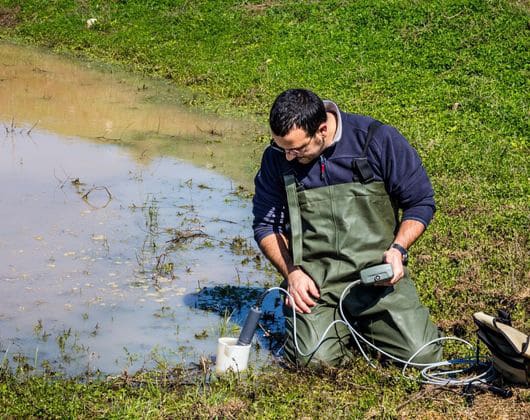ISO 14001
ISO 14001 is the principal management system standard specifying the requirements for formulating and maintaining an effective Environmental Management System (EMS).

ISO 14001 focuses on controlling an organisation's environmental aspects and how company activities, products, and services interact with the environment.
Organisations set out their intentions, adhere to procedures and record their efforts to demonstrate compliance and improvement. Objectives set must be implemented to improve an organisation's environmental performance.
The fundamental commitments required in ISO 14001 help drive improvements in overall performance: an environmental policy, prevention of pollution, compliance with legislation, and improvement of the EMS.
Organisations are required to identify applicable legal, statutory and related requirements. It is essential to determine how the legislation affects you so that compliance measures can be adopted and periodically evaluated, ensuring employees understand and implement requirements effectively.
ISO 14001 is accompanied by ISO 14004, Environmental Management systems – General Guidelines on principles, systems and support techniques. This standard covers issues such as establishing, implementing, maintaining and improving a management system and discusses the principal issues involved.
Benefits of ISO 14001:
Frequently Asked Questions
With more than 360,000 certifications issued worldwide, ISO 14001 is a widely used standard for environmental management systems.
An excellent environmental management system must be tailored to the specific needs of your business based on the legal requirements and environmental factors that affect your business. The ISO 14001 standard provides a framework and guidelines for creating an EMS, which ensures essential elements are not missed.
The framework is broad enough to serve companies in virtually any industry or sector while providing specific guidelines for sustainable practices implementation. Being ISO 14001 certified can demonstrate to management, employees, and external stakeholders that the company is measuring and improving its environmental impact.
Amidst climate change challenges and other environmental concerns, as well as evolving attitudes towards environmental responsibility, the importance of obtaining ISO 14001 has never been greater.
Becoming ISO 14001 certified ensures compliance with current and future legal regulations. The consequences of non-compliance can be devastating, making getting certified an essential step.
Better image and credibility
Customers have increasingly become more concerned with how businesses manufacture their products. Since many contracts and tenders demand ISO 14001 certification, getting certified is a clear advantage. Nevertheless, despite not being a legal requirement, many customers care about how your company treats the environment.
The best way to demonstrate commitment to environmental management is to have a system for identifying and addressing these impacts. Your ISO 14001 certification will show your customers that you take environmental responsibility seriously. As a result, it can boost your reputation, promote a positive image and strengthen your community ties, helping you gain market share.
A competitive edge
As more and more companies become ISO 14001 certified, ensuring your business does not fall behind is crucial. Having ISO 14001 certification can make you stand out from your competitors or keep you at par if they have already achieved it. The same is true if your business is bidding on a tender.
Improved control of costs
Undoubtedly, every company wants to reduce its costs. Environmental incidents that may lead to fines, clean-ups, and reparations can be identified, controlled and reduced by utilising your EMS. An environmental management system can also be cost-saving by minimising energy and input material consumption.
Moreover, increased efficiency will lead to lower operating costs. There will be a reduction in waste management costs, as well as a reduction in waste processing and removal.
- Scope
- Normative references
- Terms and definitions
- Context of the business
- Leadership
- Planning
- Support
- Operation
- Performance evaluation
- Improvement
Environmental policy
An environmental policy is a written document defining a business's goals concerning the environment. The document contains environmental sustainability principles as well as EMS performance indicators.
Efforts to continuously improve, prevent pollution and comply with regulations should be documented, implemented and constantly monitored.
It is the responsibility of the top management of the company to define its environmental policy and tailor it to its operations, products and services. The policy must be communicated clearly both internally and externally, as well as implemented in full.
Planning
Develop a comprehensive plan for implementing the EMS. Businesses can assess their environmental impact through precise, thorough planning.
When planning for EMS implementation, it is necessary to establish and maintain procedures regarding activities and products that can have a negative impact on the environment. There must be procedures for determining legal requirements and setting goals within the company while considering legal, technological, financial and operational considerations. The achievement of goals also requires that programs are maintained, including responsibilities, means and timeframes.
Implementation
The implementation of plans may include adjustments or new processes as requirements change. Implementation procedures must be clearly defined, documented and communicated to ensure proper training and compliance. By documenting your company's procedures thoroughly, you'll find it easier to improve them.
Checking and corrective action
Once the most basic EMS has been implemented, monitor its performance, and adjust as necessary. Calibration, maintenance and recording are required. Legislation and regulations should also be evaluated periodically.
Taking corrective or preventive action to eliminate actual or potential non-conformances is essential. Additionally, regular audits of the EMS are required to ensure compliance.
Management review
An EMS review ensures everything is running smoothly. Assessing this type of effect is best left to management.
Continuous improvement
An EMS will use continuous improvement principles to optimise the entire system.
- Find out more about ISO 14001
- Conduct an Initial Environmental Review and Gap Analysis
- Develop a project plan for ISO 14000
- Educate your company on 14001
- Maintain ISO 14001 documentation
- Conduct business with your EMS in place
- ISO 14001 audit of EMS
- Get your certification








